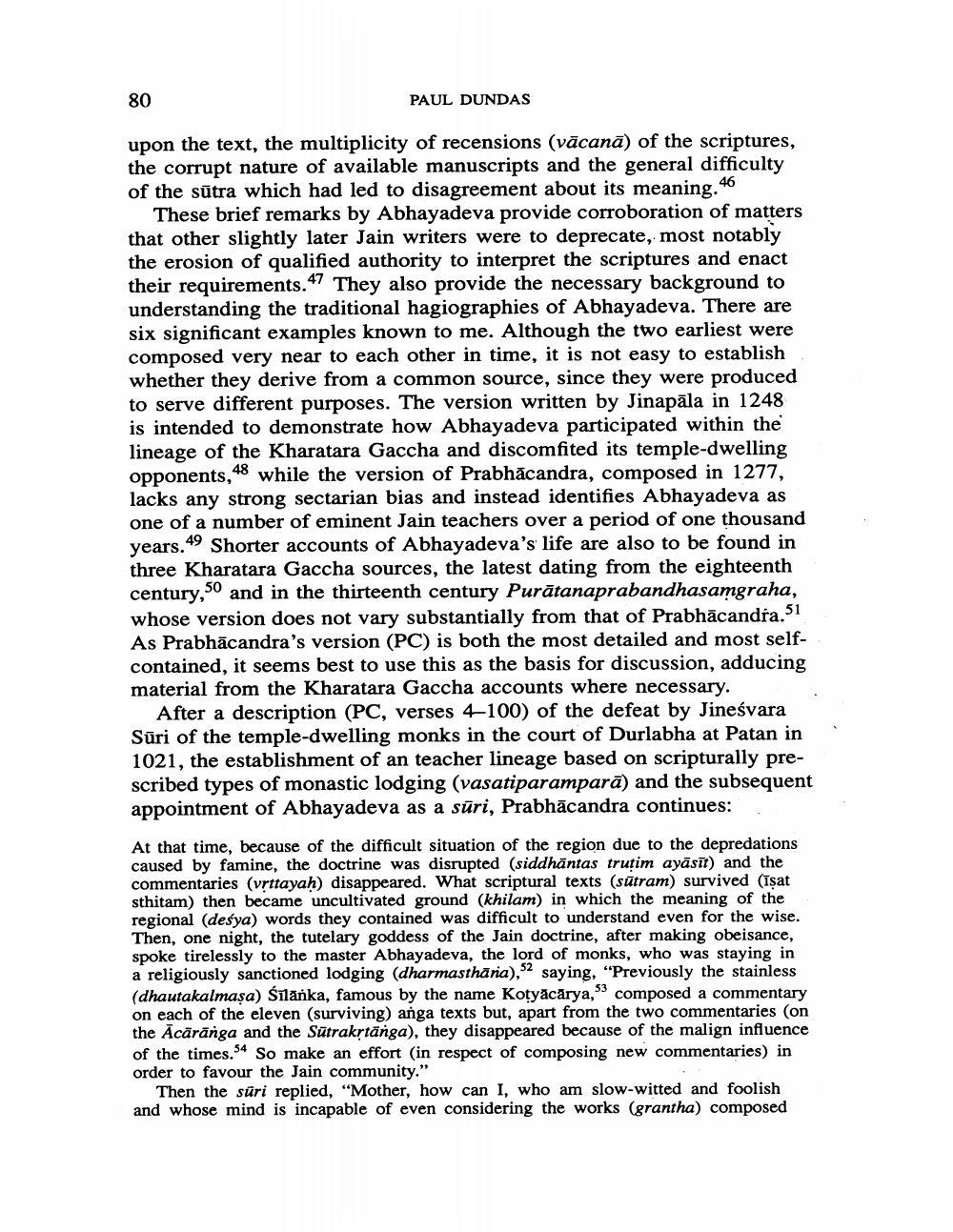Book Title: Somnolent Stras Sriptural Cmmentary In Svetambara Jainism Author(s): Paul Dundas Publisher: Paul Dundas View full book textPage 8
________________ 80 PAUL DUNDAS upon the text, the multiplicity of recensions (vācanā) of the scriptures, the corrupt nature of available manuscripts and the general difficulty of the sūtra which had led to disagreement about its meaning. 46 These brief remarks by Abhayadeva provide corroboration of matters that other slightly later Jain writers were to deprecate, most notably the erosion of qualified authority to interpret the scriptures and enact their requirements.47 They also provide the necessary background to understanding the traditional hagiographies of Abhayadeva. There are six significant examples known to me. Although the two earliest were composed very near to each other in time, it is not easy to establish whether they derive from a common source, since they were produced to serve different purposes. The version written by Jinapāla in 1248 is intended to demonstrate how Abhayadeva participated within the lineage of the Kharatara Gaccha and discomfited its temple-dwelling opponents,48 while the version of Prabhācandra, composed in 1277, lacks any strong sectarian bias and instead identifies Abhayadeva as one of a number of eminent Jain teachers over a period of one thousand years. 49 Shorter accounts of Abhayadeva's life are also to be found in three Kharatara Gaccha sources, the latest dating from the eighteenth century,50 and in the thirteenth century Purātanaprabandhasamgraha, whose version does not vary substantially from that of Prabhācandra.51 As Prabhācandra's version (PC) is both the most detailed and most selfcontained, it seems best to use this as the basis for discussion, adducing material from the Kharatara Gaccha accounts where necessary. After a description (PC, verses 4-100) of the defeat by Jineśvara Sūri of the temple-dwelling monks in the court of Durlabha at Patan ini 1021, the establishment of an teacher lineage based on scripturally prescribed types of monastic lodging (vasatiparamparā) and the subsequent appointment of Abhayadeva as a sūri, Prabhācandra continues: At that time, because of the difficult situation of the region due to the depredations caused by famine, the doctrine was disrupted (siddhäntas truřim ayasīt) and the commentaries (vrttayah) disappeared. What scriptural texts (sūtram) survived (Isat sthitam) then became uncultivated ground (khilam) in which the meaning of the regional (desya) words they contained was difficult to understand even for the wise. Then, one night, the tutelary goddess of the Jain doctrine, after making obeisance, spoke tirelessly to the master Abhayadeva, the lord of monks, who was staying in a religiously sanctioned lodging (dharmasthāra),52 saying, “Previously the stainless (dhautakalmasa) śīlanka, famous by the name Kotyācārya,53 composed a commentary on each of the eleven (surviving) anga texts but, apart from the two commentaries (on the Ācāränga and the Sūtrakrtānga), they disappeared because of the malign influence of the times.54 So make an effort (in respect of composing new commentaries) in order to favour the Jain community." Then the suri replied, "Mother, how can I, who am slow-witted and foolish and whose mind is incapable of even considering the works (grantha) composedPage Navigation
1 ... 6 7 8 9 10 11 12 13 14 15 16 17 18 19 20 21 22 23 24 25 26 27 28 29
